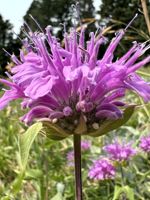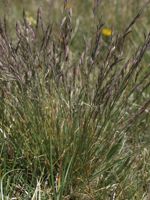Mon-Fri 9am - 5pm Mountain time
Wild Bergamot vs Rocky Mountain Fescue
Monarda fistulosa
Festuca saximontana
NOT AVAILABLE THIS SEASON - MIGHT RETURN
CUSTOM GROW
Wild Bergamot is a native perennial wildflower that is known for its fragrant lilac-purple tubular flowers. The flowers grow in dense terminal heads and bloom from mid-summer to early fall. Deadheading spent flowers will encourage new blooms, prolonging its display. They attract pollinators such as bees, butterflies, and hummingbirds. It also serves as a host plant for the Raspberry Pyrausta (Pyrausta signatalis) butterfly.
Wild Bergamot belongs to the mint family, and its leaves, stems, and flowers are all edible. The leaves can be used to make tea or as a flavorful herb, with a taste often described as a blend of oregano and thyme.
It is resistant to deer and rabbits but can be susceptible to powdery mildew if planted too densely with poor air circulation. Wild Bergamot tolerates heat, drought, and poor soils, making it a low-maintenance addition to a variety of projects. It is well suited for pollinator gardens, wildflower gardens and naturalization projects.
Rocky Mountain Fescue is a native perennial bunchgrass recognized for its fine-textured clumps and adaptability to harsh environments. It grows well in dry, rocky, and nutrient-poor soils and is highly cold-tolerant, making it well-suited to both prairie and alpine habitats. Its fibrous root system contributes to soil stability and helps reduce erosion on slopes and shallow soils.
Widespread across western and northern North America, Rocky Mountain Fescue is an important component of many prairie and alpine ecosystems. It contributes ground cover and organic matter that support soil function, provides cover for small wildlife, and offers moderate forage for grazing animals. Hardy and versatile, it is used in ecological restoration, naturalization, and habitat enhancement projects, particularly in upland and alpine landscapes.

